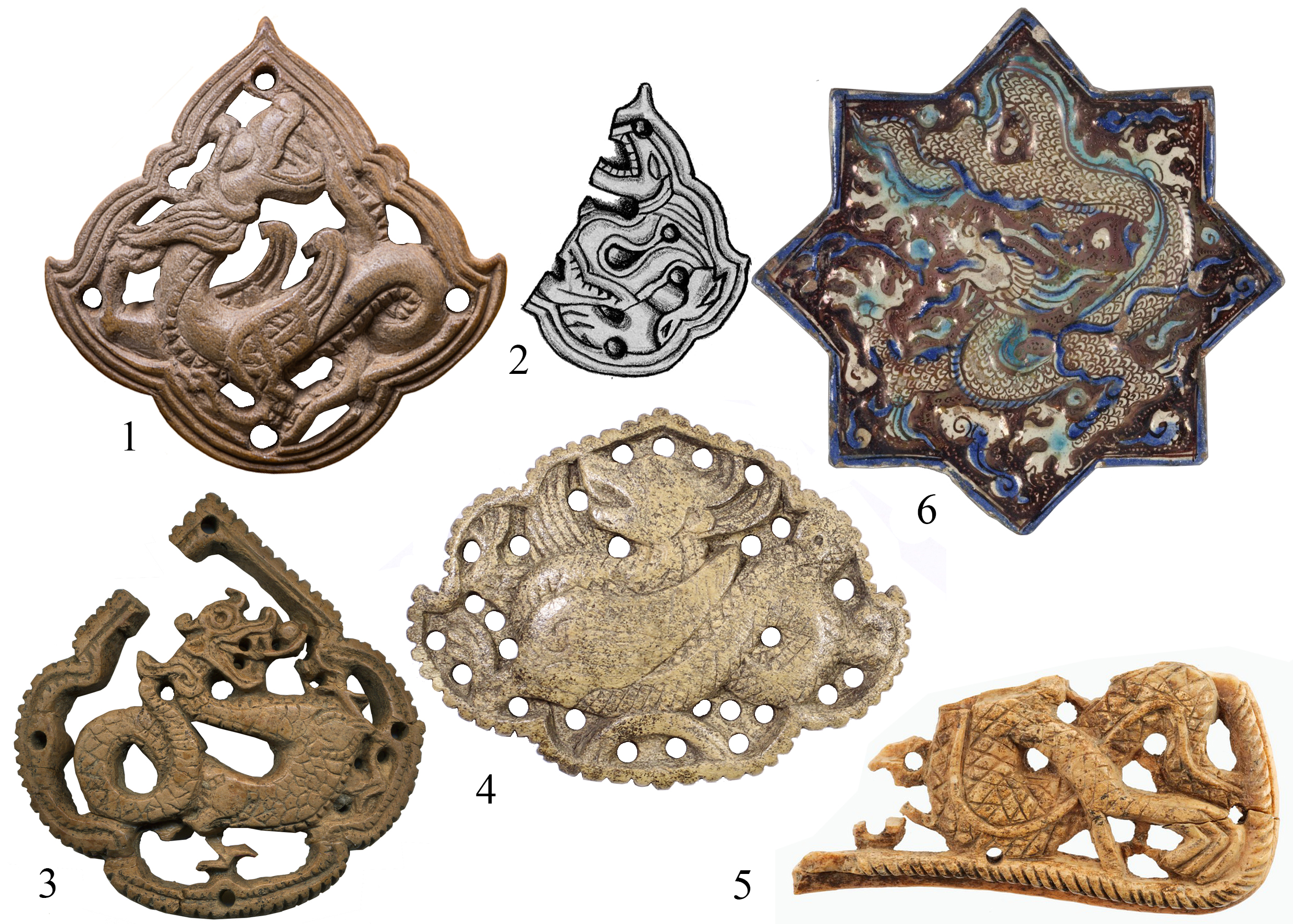The Lotus-Shape Applique with a Dragon Image from Nerevsky Site in Veliky Novgorod
DOI:
https://doi.org/10.24852/2587-6112.2023.5.124.130Keywords:
archaeology, applied art, bone carved, Golden Horde, Veliky Novgorod, Old Rus art, Mongol conquestAbstract
The material culture of Veliky Novgorod of XIII–XIV centuries shows a pronounced influence of Eastern fine art, brought by new contacts with the vast art world of the Golden Horde. Along with mass-scale artefacts distinguished artistic objects come across. One of them is the horn lotus-shaped applique with a dragon image from the Nerevsky site in Veliky Novgorod. This image has a number of stylistic analogies among archaeological artefacts of Golden Horde cities. The main problem of the article deals with the analysis of the origin of this image. The Golden Horde art was formed by strong influence of China. This process was reflected in some artistic objects, which were decorated with dragon images with typical style and iconography. Veliky Novgorod dragon, like other similar images, doesn’t find absolute analogies among the Golden Horde items, inspired by the Yuan Dynasty. These features demonstrate the hybrid nature of the artistic image from Veliky Novgorod.
References
Astashova, N. A. 1993. In Nedoshivina, N. G. (ed.). Srednevekovye drevnosti Vostochnoi Evropy (Medieval Antiquities of Eastern Europe). Series: Trudy Gosudarstvennogo istoricheskogo muzeya (Proceedings of the State Historical Museum) 82. Moscow: State Historical Museum, 69–78 (in Russian).
Gribov, N. N. 2007. In Shpolianskii, S. V. (ed.). Arkheologiya Vladimiro-Suzdal'skoy Rusi (Archaeology of Vladimir-Suzdal land) 1. Moscow: Institute of Archaeology, Russian Academy of Sciences Publ., 58–67 (in Russian).
Isakov, R. V., Afonkov, N. N., Sheremet’ev, A. G., Arkhangelsky, M. S. 2013. In Tairov, A. D., Ivanova, N. O. (eds.). Etnicheskie vzaimodeystviya na Yuzhnom Urale (Ethnic Interactions in the Southern Urals). Chelyabinsk: “Rifei” Publ., 212–226 (in Russian).
Kolchin, B. A., Yanin, V. L. 1982. In Kolchin, B. A., Yanin, V. L. (eds). Novgorodskii sbornik (50 let raskopok Novgoroda) (Novgorod Collected Works (50 Years of Excavations in Novgorod)). Moscow: “Nauka” Publ., 3‒137 (in Russian).
Kolchin, B. A., Yanin, V. L., Yamschikov, S. V. 1985. Drevniy Novgorod. Prikladnoe iskusstvo i arkheologiya (Ancient Novgorod. Applied art and archaeology). Moscow: “Art” Publ. (in Russian).
Kramarovskiy, M. G. 2001. In Usmanov, M. A. (ed.). Istochnikovedenie istorii Ulusa Dzhuchi (Zolotoi Ordy) ot Kalki do Astrakhani 1223–1556 (Source Studies on the History of the Ulus of Jochi (the Golden Horde) from Kalka to Astrakhan of 1223–1556). Kazan: Institute of History named after Shigabuddin Mardzhani, Tatarstan Tatarstan Academy of Sciences, 43–81 (in Russian)..
Kramarovskiy, M. G. 2001. Zoloto Chingisidov: kul'turnoye naslediye Zolotoy Ordy (Gold of Genghisid: the cultural heritage of the Golden Horde). Saint Petersburg: “Slaviya” Publ. (in Russian).
Kozlova, A. V. 2004. In Yanin. V. L. (ed.). Novgorod i Novgorodskaia zemlia istoriia i arkheologiia (Novgorod and Novgorod Land. History and Archaeology) 18. Veliky Novgorod: The Novgorodian State Reserve Museum, 188–207 (in Russian).
Kozlova, A. V. 2006. Vostochnye traditsii ukrasheniy i predmetov byta iz tsvetnykh metallov v gorodakh severo-zapadnoy Rusi i sopredel'nykh territoriy (Oriental traditions of jewelry and household items made of non-ferrous metals in the cities of North-Western Russia and adjacent territories) Diss. of the Candidate of Historical Sciences. Moscow (in Russian).
Kubankin D. A. 2013. In Yudin, A. I. (ed.). Arkheologicheskoe nasledie Saratovskogo kraia (The Archaeological Heritage of the Saratov Region) 12. Saratov: “Nauchnaya kniga” Publ., 144–154 (in Russian).
Kubankin, D. A. 2014. In Sitdikov A. G., Makarov N. A., Derevianko A. P. (eds.). Trudy IV (XX) Vserossiiskogo arkheologicheskogo s″ezda v Kazani (Proceedings of the 4th (20th) All-Russia Archaeological Congress in Kazan) III. Kazan: “Otechestvo” Publ., 388–392 (in Russian).
Baranov, V. S., Bugrov, D. G., Sitdikov, A. G. 2016. Muzei bolgarskoi tsivilizatsii. T. 1. Drevnii Bolgar: zhizn' goroda. (Museum of Bolgar Civilization. Vol. 1. Ancient Bolgar: Life of the City). Kazan: “Glavdizain” Publ. (in Russian).
Obukhov, Yu. D., Bocharov, S. G. 2018. In Povolzhskaya arkheologiya (Volga River Region Archaeology) 24 (2), 125–133 (in Russian).
Shalobudov, V. N. 1995. In Kovaleva, I. F. (ed.). Problemy arkheologii Podneprov'ia (Archaeological Issues of the Dnieper Region). Dnepropetrovsk: Dnepropetrovsk State university, 110‒119 (in Russian).
Yurchenko, A. G. 2013. Elita mongol'skoi imperii: vremia prazdnikov, vremia kaznei (The Elite of the Mongol Empire: Time for Festivities, Time for Executions). Saint Petersburg: Evraziia Publ. (in Russian).
Komaroff, L., Carboni, S. (ed.) 2002. The Legacy of Genghis Khan. Country Art and Culture of Western Asia, 1256 – 1353. New York: Metropolitan Museum.
Bowl. Available at: https://www.metmuseum.org/art/collection/search/448663?when=A.D.+1400-1600&ft=bowl&offset=0&rpp=40&pos=3 (accessed on: 22.12.2022)
Dish with Two Intertwined Dragons. Available at: https://www.metmuseum.org/art/collection/search/451804?deptids=14&high=on&ft=dragon&offset=0&rpp=40&pos=6 (accessed on: 22.12.2022)
Izrazets (tile). Available at: https://www.hermitagemuseum.org/wps/portal/hermitage/digital-collection/08.+applied+arts/179326 (accessed on: 22.12.2022)

Downloads
Published
How to Cite
Issue
Section
License
Copyright (c) 2023 N.N. Tochilova

This work is licensed under a Creative Commons Attribution-NonCommercial 4.0 International License.







